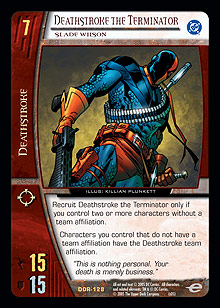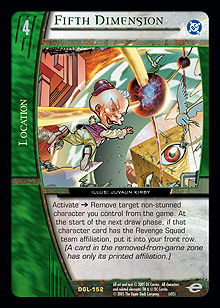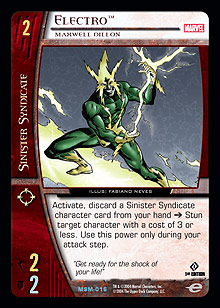
Hi, all.
I have a bumper column for you today, chock full of reader questions and brimming with recent expansion goodness!
Read on if you’d like to know more about any or all of Sinestro, Lantern in Exile; Kyle Rayner, Green Lantern of the Universe; Chopping Block; Green Lantern Ring; Fifth Dimension; Mosaic World; Hard-Traveling Heroes; Rain of Acorns; The Fall of Oa; No Man Escapes the Manhunters; and last but not least, Lanterns in Love.
As always, we’ll kick off proceedings with the feature question. Today we have a two-parter that weaves its way around my favorite topic of dependency.
 If my opponent controls Ra’s al Ghul, The Demon’s Head, and I control three characters, can I play Deathstroke the Terminator?
If my opponent controls Ra’s al Ghul, The Demon’s Head, and I control three characters, can I play Deathstroke the Terminator?
Ben D., PhoenixAZ
If at least two of the three characters you control don’t have the League affiliation, then yes. Ra’s al Ghul’s continuous modifier will remove any other affiliation(s) they have, allowing you to play Deathstroke.
And if I do, will they all gain the Deathstroke affiliation and keep it, or gain it then lose it because of Ra’s al Ghul?
This is a dependency question (and arguably the most famous, so it’s about time that it made it into this column). Ra’s al Ghul’s modifier can change whether or not a character you control is unaffiliated, so Deathstroke’s modifier depends on Ra’s al Ghul’s. Deathstroke’s modifier cannot change whether or not a character has the League affiliation, so Ra’s al Ghul’s modifier does not depend on Deathstroke’s.
Dependent modifiers are applied after the modifiers they depend on. As a result, Ra’s al Ghul’s is applied first, and then Deathstroke’s, so your non-League characters will have the Deathstroke affiliation.
I control an unaffiliated character equipped with Green Lantern Ring and use Forced Allegiance to change its affiliation. If I later transfer the Ring, will the character keep the affiliation given by the Allegiance?
Ben D., PhoenixAZ
Nope. While the unaffiliated character is wearing the Ring, that character is affected first by the ring’s modifier (making it affiliated) and then by Allegiance’s modifier.
After the Ring is transferred, that character is no longer affected by the Ring’s modifier and so is no longer affected by Allegiance’s modifier (since that character is no longer affiliated).
I read your latest column and was interested to know what happens to Lex Luthor, President Luthor when he comes into play from the Fifth Dimension. Since he states that you “cannot draw,” do you still draw the normal two cards? Or does he come into play at the same time that the “draw two cards” effect goes on the chain?
Ken
 A fine question. The answer is that you cannot draw the normal two cards.
A fine question. The answer is that you cannot draw the normal two cards.
The draw phase begins by putting the “draw two cards” effect on the chain. Then, any triggers that fire at the start of the draw phase (like Fifth Dimension’s) add their effects to the chain.
As a result, Fifth Dimension’s triggered effect will resolve first, and Lex will be in play when the “draw two cards” effect resolves. When it does, Lex’s controller will not draw two cards because Lex reads, “You cannot draw cards during the draw phase.”
Just to be hyper-clear, Lex’s modifier does not stop card drawing effects from going on the chain, nor does it stop them from resolving. It just “suppresses” any card drawing modifiers created by such effects.
My opponent pays 2 endurance for Rot Lop Fan’s power twice, targeting Olapet and Kyle Rayner, Last Green Lantern. Olapet and Kyle team attack Kiman, so I exhaust Kiman to give Olapet -3 DEF and then pay 1 to stun Olapet with Kiman’s other power. Finally, my opponent exhausts two other characters to recover Olapet with Lanterns in Love. Olapet loses the team attacker characteristic when stunned, but does he regain it when recovered?
Richard W.
No, he doesn’t. Characters only gain the team attacker characteristic when a team-attack in which they’ve been proposed passes the legality check, causing them to exhaust. If a character loses it prior to attack conclusion, there’s no way for that character to regain it before that attack concludes.
What cards will be legal in the DC Modern format used for Pro Circuit Indy? I’ve read that only DSM and DGL are legal, but local TOs are saying that the cards in the recent DC Batman starter are also legal.
Todd M.
Your local TOs are wise. The legal card pool will indeed be Man of Steel, Green Lantern, and the Batman starter, just as the Fantastic Four starter was legal for $10K Manila’s Marvel Modern Age format. According to the Vs. System policy document (http://entertainment.upperdeck.com/op/policy/vs_policy.aspx), both of the new starters became tournament legal on June 1, 2005.
I’ve got a question for you revolving around Sinestro, Lantern in Exile and Kyle Rayner, Green Lantern of the Universe. Now, assuming I’m not a complete moron here (and I hope I’m not), if I target my own character with Sinestro and move Kyle to the hidden area, wouldn’t that mean that none of my visible protected characters could be attacked?
Drew B.
Yup, so far so good . . .
It seems to me that this may be a problem similar to Blob in the hidden area, but I wanted to check before I bust this cheese out at our next Friday night playtest marathon.
A hidden Blob is a far uglier proposition because he can effectively shut down all attacks against a visible area if all the characters positioned there are support row Brotherhood. That’s why he was errata’d.
When facing a hidden Kyle, if you want to attack a certain protected character, you’re merely forced to stun the single visible character protecting that protected character first, which is not as daunting a task.
I have three questions for you regarding willpower. First, say an opponent controls two characters from different teams, each with willpower 1, and he plays Hard-Traveling Heroes. If I respond by targeting one of them with Dimming of the Starheart, do I stop the team-up?
Mon
Effectively, yes. The “choose two or more affiliations” effect resolves, but your opponent can only choose one, so he doesn’t draw a card and the continuous modifier generated by the ongoing part of the plot twist effectively does nothing.
It’s my opponent’s attack step. He controls one ready character with willpower 1 and flips Rain of Acorns. I respond by playing Dimming of the Starheart on his character. Can he respond by using Rain of Acorns to exhaust one of my characters? I’m thinking no, because the Acorns hasn’t flipped up yet, right?
 Excellent question, but the answer is yes. Flipping a plot twist is done on announcement and doesn’t use the chain, so its ongoing payment power(s) can be used immediately once its controller gets priority.
Excellent question, but the answer is yes. Flipping a plot twist is done on announcement and doesn’t use the chain, so its ongoing payment power(s) can be used immediately once its controller gets priority.
(Note, however, that any text before the word “ongoing” does use the chain. And in cases like Rain of Acorns where there is no such text, a “blank effect” is put on the chain, which simply resolves after successive passes without creating a modifier.)
So, after flipping Rain of Acorns, your opponent retains priority and may immediately exhaust a character with willpower 1 or greater he controls to target an unprotected character. Then he retains priority again. Only when he passes can you play Dimming of the Starheart, by which time he’s already exhausted his character.
My opponent recruits Chopping Block targeting a character with willpower 1. If I respond by playing Dimming of the Starheart to reduce the target’s willpower to 0, what happens to the Chopping Block?
It comes into play equipping its target because, again, it’s too late to respond. Your opponent pays costs as the recruit effect is played and retains priority. Only when the opponent passes can you play Dimming of the Starheart, by which time the recruit cost has already been paid (which was 1 less at the time).
Does Mosaic World allow my characters to team attack as though they had any team affiliation, or only any team affiliation among characters I control? I mean, for example, could I specify that my characters are team attacking with the Gotham Knights affiliation (even though I have no Gotham Knights characters in play), and then flip Dynamic Duo to prevent them from becoming stunned?
Jake S., Rockville, MD
No, because Mosaic World doesn’t actually change or add to the affiliation(s) of any of your characters. It simply means that those that can attack legally can team attack legally, regardless of affiliation.
 My opponent controls Huntress, Helena Rosa Bertinelli, and I propose an attack on her. Am I able to target her with No Man Escapes the Manhunters before she gains the defender characteristic this attack?
My opponent controls Huntress, Helena Rosa Bertinelli, and I propose an attack on her. Am I able to target her with No Man Escapes the Manhunters before she gains the defender characteristic this attack?
Nige A., Scotland
That’s correct. She doesn’t become a defender until you both pass after the attack proposal. Note that you can target her before the attack proposal, as well (or even before the combat phase, if you like).
But when she does become a defender, is she targeted again by the delayed trigger modifier from the plot twist?
No, it’s not a DTM because it doesn’t say “when,” “whenever,” or “at the start.” It’s simply a continuous modifier from an effect that only does something while the character that was targeted is defending this turn. It doesn’t “trigger” or “target” when that character becomes a defender; it just starts doing something.
If the only character I have in play is Ra’s al Ghul, Immortal Villain, am I able to recruit Ra’s al Ghul, Master Swordsman?
Dan O., San Antonio, TX
Yep, that works fine. The loyalty restriction is checked (successfully) as you play Master Swordsman’s recruit effect. Then, after successive passes, the uniqueness rule puts Immortal Villain into the KO’d pile as part of resolving that recruit effect.
If I control two face-up plot twists named The Fall of Oa, do I put one or two cards from a target player’s deck into his or her KO’d pile when I exhaust a Manhunter character? I know, for example, that multiple Concrete Jungles trigger multiple discards. When I exhaust a Manhunter character, am I really saying, “I exhaust this character for this particular plot twist’s effect,” and therefore only put one card into the KO’d pile?
Paul
That’s exactly right. You’re paying the cost of a specific payment power.
You’re also correct in that two Concrete Jungles have two different triggered powers, both of which trigger independently whenever an opponent flips a location, ultimately causing the discard of two cards from the two different triggered effects. The difference is that The Fall of Oa has a payment power rather than a triggered power.
Is Will O’ the Wisp only considered to have recovered if he goes from stunned to face up? Imagine a situation where there are two effects to recover him on the chain. When the first resolves, he recovers and gets a +1 ATK/+1 DEF counter. When the second effect resolves, is he considered to have recovered again, thus getting a second counter?
Adam E.
Yes to the first question and no to the second. Recovery is defined as an event that takes away the stunned characteristic. In other words, Will can’t recover if he’s already recovered.
If he was face up, you could still target him with a “recover target character” effect, but it would do nothing on resolution and his trigger would not fire.
 Let’s say I have equipped a Titanium Sword to Electro. When he stuns my opponent’s 3-drop via his power, does my opponent lose the extra 3 endurance via Titanium Sword? I have asked this of many people I play with, and the most common reply is no, because it’s his power stunning the 3-drop, not Electro himself. Now correct me if I’m wrong, but isn’t the power to stun a character with cost 3 or less Electro’s power? Therefore, isn’t Electro stunning the character?
Let’s say I have equipped a Titanium Sword to Electro. When he stuns my opponent’s 3-drop via his power, does my opponent lose the extra 3 endurance via Titanium Sword? I have asked this of many people I play with, and the most common reply is no, because it’s his power stunning the 3-drop, not Electro himself. Now correct me if I’m wrong, but isn’t the power to stun a character with cost 3 or less Electro’s power? Therefore, isn’t Electro stunning the character?
Aaron M., Sanford, ME
Yes, you’re not wrong. If Electro’s activated effect resolves, then Electro himself has stunned the target because he was the source of the modifier that stunned the target. If he is equipped with Titanium Sword, then the sword’s power will indeed trigger.
My friend attacked my Punisher, Jury, and when his triggered effect resolved, I equipped a Mystic Chain onto Punisher. My friend said that I couldn’t, since Mystic Chain can only be recruited if you control three or more characters and I only controlled two characters at the time. I argued that this wasn’t like, say, The Pogo Plane, which can only be equipped to a Fantastic Four character. The restriction of controlling three or more characters applies only to recruitingMystic Chain, not to simply putting it into play.
Carlos A., EdmontonAB
You’re absolutely correct.
Another question about Mystic Chain not related to the situation above: Mystic Chain’s effect where an opponent discards a card and you draw a card triggers whenever the equipped character “causes breakthrough to a player.” Does it trigger only on a direct attack against a player, or on any breakthrough?
It will trigger on any breakthrough, whether from a direct attack against a player or a non–team attack against a character.
Based on the question from the last Cerebro about Antarctic Research Base granting a card draw even if the target of an equipment’s recruit effect ends up being illegal on resolution, would it not be legal, once you control Mr. Fantastic, Stretch and at least one equipment, to recruit an equipment targeting an unequipped character, then pay 2 endurance to transfer an equipment to that character? The equipment does not get recruited and stays in hand, and you draw a card from Antarctic Research Base . . . right?
Ryan A.
It works fine until the “equipment does not get recruited and stays in hand.” If its target is illegal on resolution, the equipment actually goes to the KO’d pile. You would draw a card from the ARB, though.
So, with that last question allowing me to finish more or less triumphantly on theme for Fantastic Four week, it’s time to draw another rules column to a reluctant close. Join me week after next for Cerebro’s first peek at Avengers! Until then, please keep those rules questions coming in to vsrules@gmail.com.
P.S. Good luck to all readers competing in Singapore this weekend!